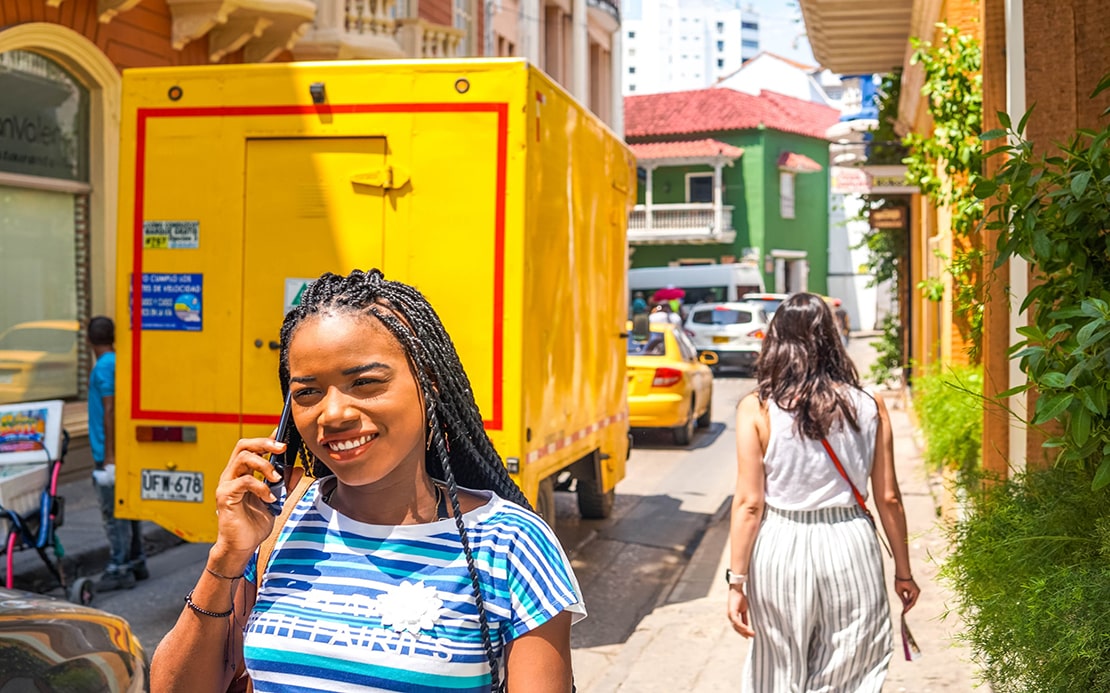Whether you’re a parent sending your recent high school graduate abroad, or you are volunteering overseas yourself, communicating with your family while out of the country is important. With the technology available today, there are a number of ways to stay in touch.
How Do You Call Internationally?
If you’re lucky, the person volunteering abroad may have internet access, in which case you can use Wi-Fi calling or a video calling service like Google Hangouts or Facebook Messenger to connect.
On the other hand, if you choose to call over the phone, there are a few things you should know. Calling overseas is slightly more complicated than calling within the United States. There are a number of factors to consider including data rates, international calling codes, and country codes.
In this article, we’ll talk particularly about international calling codes and country codes. What are they? How are they different? And why are the important? We’ll discuss these questions and more.
Are International Calling Codes Different From Country Codes?
Yes. International calling codes are different from country codes. Often called international direct dial (IDD) designations, international calling codes are more general. To put it simply, the IDD for most of the countries in the world is 00 or 011.
What Are International Calling Codes?
International calling codes (also known as call prefixes or dial out codes) enable you to access the correct international telephone circuit to place an international call. Typically, the international calling code must be entered before the country code.
What Are Country Codes?
Country codes are a group of numbers you enter before dialing the number of the person in the country you are calling. The country code is entered after the international calling code or prefix. Each country has its own unique code. For example, the country code for the United States is +1. So if someone wanted to call you in the United States from another country, they would simply type +1 and then your phone number, also including your area code. The country code for the UK is +44, and Mexico’s country code is +52. Interestingly, Canada shares the same +1 country code with the US.
Why Do You Need to Use An International Calling Code and Country Code?
The international calling code is needed to help the phone company understand where you would like your call to be routed. Understandably, with so many countries in the world, a way to ensure every call is routed to the right place is essential.
What Are the Most Common Country Codes for Making Calls Abroad?
- Country code to call the United States or Canada: +1
- Country code to call the United Kingdom (UK): +44
- Country code to call Mexico: +52
- Country code to call India: +91
- Country code to call China:+86
What Are the Steps to Make an International Call?
- Dial the IDD. It is generally 00 or 011. See a full list here.
- Enter the correct country code.
- Dial the desired number, omitting the first zero if one is present.
What Are All the Country Calling Codes?
Below is a list of country calling codes for your convenience.
93: Afghanistan
355: Albania
213: Algeria
684: American Samoa
376: Andorra
244: Angola
809: Anguilla
268: Antigua
54: Argentina
374: Armenia
297: Aruba
247: Ascension Island
61: Australia
672: Australian External Territories
43: Austria
994: Azerbaijan
242: Bahamas
246: Barbados
973: Bahrain
880: Bangladesh
375: Belarus
32: Belgium
501: Belize
229: Benin
809: Bermuda
975: Bhutan
284: British Virgin Islands
591: Bolivia
387: Bosnia and Herzegovina
267: Botswana
55: Brazil
284: British V.I.
673: Brunei Darussalam
359: Bulgaria
226: Burkina Faso
257: Burundi
855: Cambodia
237: Cameroon
1: Canada
238: Cape Verde Islands
1: Caribbean Nations
345: Cayman Islands
236: Central African Republic
235: Chad
56: Chile
86: China (People’s Republic)
886: China-Taiwan
57: Colombia
269: Comoros and Mayotte
242: Congo
682: Cook Islands
506: Costa Rica
385: Croatia
53: Cuba
357: Cyprus
420: Czech Republic
45: Denmark
246: Diego Garcia
767: Dominica
809: Dominican Republic
253: Djibouti
593: Ecuador
20: Egypt
503: El Salvador
240: Equatorial Guinea
291: Eritrea
372: Estonia
251: Ethiopia
500: Falkland Islands
298: Faroe (Faeroe) Islands (Denmark)
679: Fiji
358: Finland
33: France
596: French Antilles
594: French Guiana
241: Gabon (Gabonese Republic)
220: Gambia
995: Georgia
49: Germany
233: Ghana
350: Gibraltar
30: Greece
299: Greenland
473: Grenada/Carriacou
671: Guam
502: Guatemala
224: Guinea
245: Guinea-Bissau
592: Guyana
509: Haiti
504: Honduras
852: Hong Kong
36: Hungary
354: Iceland
91: India
62: Indonesia
98: Iran
964: Iraq
353: Ireland (Irish Republic; Eire)
972: Israel
39: Italy
225: Ivory Coast (La Cote d’Ivoire)
876: Jamaica
81: Japan
962: Jordan
7: Kazakhstan
254: Kenya
855: Khmer Republic (Cambodia/Kampuchea)
686: Kiribati Republic (Gilbert Islands)
82: Korea, Republic of (South Korea)
850: Korea, People’s Republic of (North Korea)
965: Kuwait
996: Kyrgyzstan
371: Latvia
856: Laos
961: Lebanon
266: Lesotho
231: Liberia
370: Lithuania
218: Libya
423: Liechtenstein
352: Luxembourg
853: Macao
389: Macedonia
261: Madagascar
265: Malawi
60: Malaysia
960: Maldives
223: Mali
356: Malta
692: Marshall Islands
596: Martinique (French Antilles)
222: Mauritania
230: Mauritius
269: Mayolte
52: Mexico
691: Micronesia (F.S. of Polynesia)
373: Moldova
33: Monaco
976: Mongolia
473: Montserrat
212: Morocco
258: Mozambique
95: Myanmar (former Burma)
264: Namibia (former South-West Africa)
674: Nauru
977: Nepal
31: Netherlands
599: Netherlands Antilles
869: Nevis
687: New Caledonia
64: New Zealand
505: Nicaragua
227: Niger
234: Nigeria
683: Niue
850: North Korea
1 670: North Mariana Islands (Saipan)
47: Norway
968: Oman
92: Pakistan
680: Palau
507: Panama
675: Papua New Guinea
595: Paraguay
51: Peru
63: Philippines
48: Poland
351: Portugal (includes Azores)
1 787: Puerto Rico
974: Qatar
262: Reunion (France)
40: Romania
7: Russia
250: Rwanda (Rwandese Republic)
670: Saipan
378: San Marino
239: Sao Tome and Principe
966: Saudi Arabia
221: Senegal
381: Serbia and Montenegro
248: Seychelles
232: Sierra Leone
65: Singapore
421: Slovakia
386: Slovenia
677: Solomon Islands
252: Somalia
27: South Africa
34: Spain
94: Sri Lanka
290: St. Helena
869: St. Kitts/Nevis
508: St. Pierre &(et) Miquelon (France)
249: Sudan
597: Suriname
268: Swaziland
46: Sweden
41: Switzerland
963: Syrian Arab Republic (Syria)
689: Tahiti (French Polynesia)
886: Taiwan
7: Tajikistan
255: Tanzania (includes Zanzibar)
66: Thailand
228: Togo (Togolese Republic)
690: Tokelau
676: Tonga
1 868: Trinidad and Tobago
216: Tunisia
90: Turkey
993: Turkmenistan
688: Tuvalu (Ellice Islands)
256: Uganda
380: Ukraine
971: United Arab Emirates
44: United Kingdom
598: Uruguay
1: USA
7: Uzbekistan
678: Vanuatu (New Hebrides)
39: Vatican City
58: Venezuela
84: Vietnam
1 340: Virgin Islands
681: Wallis and Futuna
685: Western Samoa
381: Yemen (People’s Democratic Republic of)
967: Yemen Arab Republic (North Yemen)
381: Yugoslavia (discontinued)
243: Zaire
260: Zambia
263: Zimbabwe
Placing an International Call While Volunteering Abroad
Navigating the ins and outs of international calling is certainly not always easy. If your child is studying abroad, it’s likely they’ll have a guide or mentor who can help them determine how to call home. That said, hopefully this article has been helpful. With the right information, it’s possible to communicate with loved ones even when they are volunteering abroad.

























Volunteer Forever · Editorial Team
The mission of Volunteer Forever is to make it easier for people to volunteer, teach, intern, and travel around the world by helping them find and fund their trips abroad.